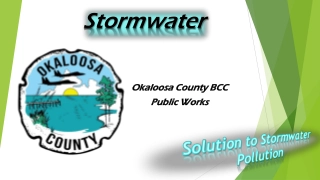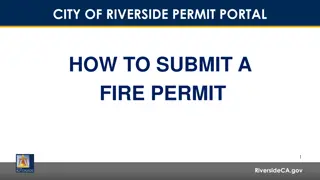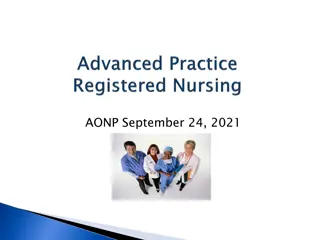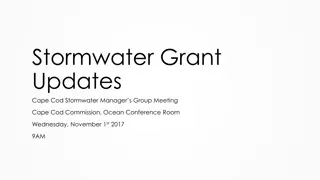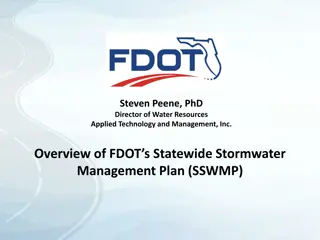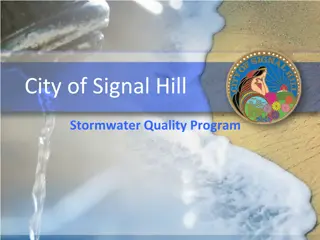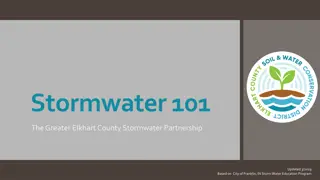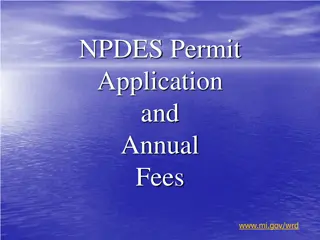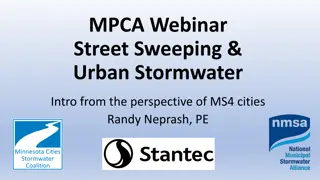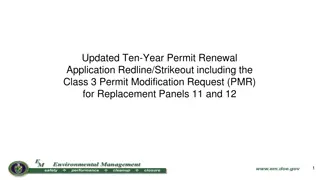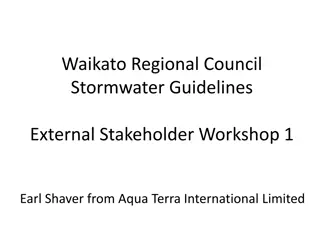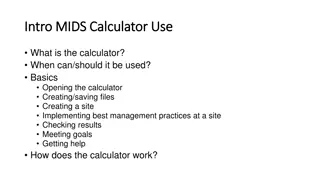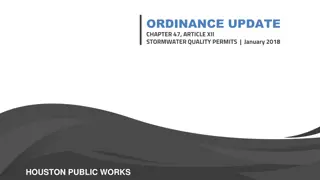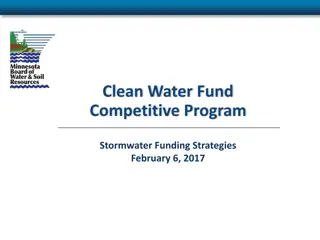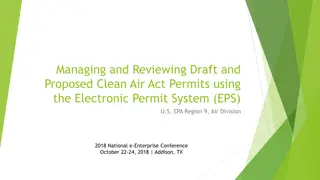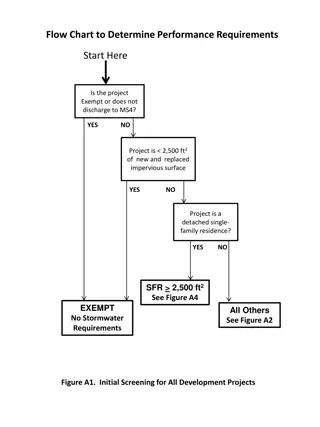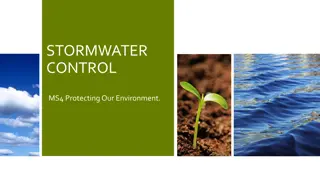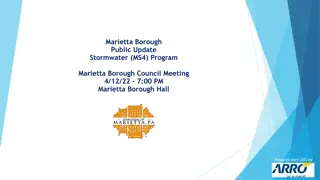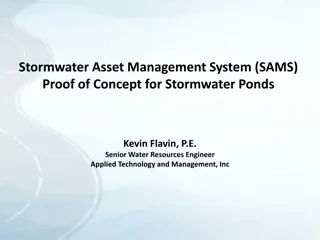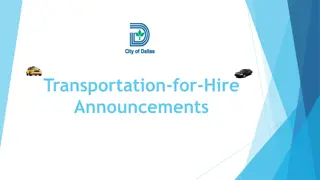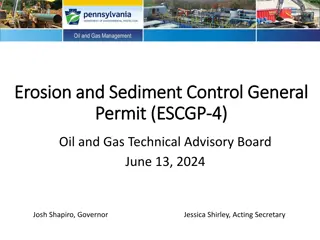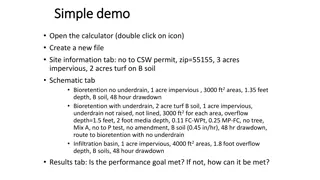Overview of OKR05 Permit for Stormwater Regulation in Oklahoma
Presented by Dr. Carrie J. Evenson, this overview covers the regulatory history of stormwater permits in Oklahoma, from the Clean Water Act to the delegation of NPDES programs to ODEQ. It further explains the requirements for different phases of stormwater regulations and DEQ's authority over stormwater discharges from various sources.
Uploaded on Oct 09, 2024 | 1 Views
Download Presentation

Please find below an Image/Link to download the presentation.
The content on the website is provided AS IS for your information and personal use only. It may not be sold, licensed, or shared on other websites without obtaining consent from the author.If you encounter any issues during the download, it is possible that the publisher has removed the file from their server.
You are allowed to download the files provided on this website for personal or commercial use, subject to the condition that they are used lawfully. All files are the property of their respective owners.
The content on the website is provided AS IS for your information and personal use only. It may not be sold, licensed, or shared on other websites without obtaining consent from the author.
E N D
Presentation Transcript
OKR05 Permit Overview Presented By: Carrie J. Evenson, Ph.D., P.E. Industrial Wastewater Enforcement Section Water Quality Division Department of Environmental Quality
Outline Regulation History Stormwater Permits in Oklahoma OKR05 Who? What? Where? When?
Regulatory History Clean Water Act Passed in 1972 Focused on point source discharges Pipes, drains, easily identified points of discharge Established the National Pollutant Discharge Elimination System (NPDES) Amended in 1987 Addressed more diffuse sources of pollution, such as stormwater discharges
Regulatory History Stormwater Regulations Phase I Promulgated in 1990 Required the following to be permitted: Medium and large municipal separate storm sewer systems (MS4s) generally with populations 100,000 Construction activities disturbing 5 acres Industrial activities
Regulatory History Stormwater Regulations Phase II Established December 8, 1999 Required the following to be permitted: Small and medium MS4s and those within urbanized areas Construction activities disturbing 1 acre or part of a larger common plan of development
Regulatory History Delegation of NPDES Programs to ODEQ November 19, 1996 Permitting and enforcement of municipal and industrial wastewater September 9, 1997 Stormwater discharges associated with construction and industrial sites Industrial pretreatment
Stormwater Programs DEQ has regulatory authority over the following stormwater discharges: From MS4s From industrial activities From construction activities Through the requirements of individual permits or OKG11 (concrete batch plants)
MS4s Municipal Separate Storm Sewer Systems
Oklahomas MS4 Permit Holders Phase I (2 permittees) Individual Permits City of Oklahoma City First issued September 1, 1995 City of Tulsa First issued April 1, 1997 Both are co-permittees with ODOT and OTA Both are co-permittees with ODOT and OTA Pollution Prevention Approach Includes a requirement to address runoff from industrial and high risk runoff sites
Oklahomas Phase II MS4 Permits Phase II (43 permittees) General Permit, OKR04 34 Cities 5 Counties 4 Non-Traditional Entities (e.g. Tinker AFB, OU) Other entities including ODOT will be permitted when OKR04 is reauthorized Pollution prevention approach Must address six minimum control measures Includes public education and outreach, illicit discharges, construction site stormwater runoff, and good housekeeping
Local Stormwater Permits Oklahoma City and Tulsa Have own stormwater permitting requirements Required as part of MS4 program Can be more stringent than state requirements Be sure to check with local authorities to ensure you have the appropriate permits and are meeting all local stormwater regulations
Industrial Stormwater Multi-Sector General Permit for Stormwater Discharges Associated with Industrial Activities, OKR05
OKR05 Applies to certain industrial activities Defined by the Standard Industrial Classification (SIC) code Listed in Table 1-2 of permit by sector Only those industrial activities with SIC code in Table 1-2 need to have permit coverage Can cross-reference SIC code with NAICS code
No Exposure Certification No permit coverage needed due to existence of a condition of no exposure. Occurs when facility provides a storm resistant shelter to prevent exposure to rain, snow, snowmelt, and / or runoff protects all industrial materials and activities Items not required to be under cover: Tightly sealed drums, barrels, tanks, and similar containers "Sealed" = banded or otherwise secured and without operational taps or valves Adequately maintained vehicles used in material handling Final products if unable to be mobilized in stormwater
No Exposure Checklist Are any of the following activities/materials exposed to stormwater? 1. Using, storing, or cleaning industrial machinery or equipment 2. Materials/residuals on ground or in stormwater inlets from spills/leaks 3. Materials/products from past industrial activity 4. Material handling equipment 5. Materials/products during loading / unloading or transporting 6. Materials/products stored outdoors (except finished products intended for outside use)
No Exposure Checklist Are any of the following activities/materials exposed to stormwater? 7. Materials contained in open, deteriorated, or leaking storage drums, barrels, tanks, etc. 8. Materials/products handled/stored on roads or railways owned or maintained by the discharger 9. Waste Material (except waste in covered, non-leaking containers) 10. Application or disposal of process wastewater 11. Particulate matter or visible deposits of residuals from roof stacks and/or vents not otherwise regulated (i.e., under an air quality control permit) and evident in the storm water outflow
Basic Requirements Submit a Notice of Intent (NOI) and permit application fee Develop and Implement a Stormwater Pollution Prevention Plan (SWP3) Pay annual permit fees Receive an authorization from DEQ Install and maintain best management practices (BMPs) Conduct quarterly visual monitoring Perform regular site inspections
NOI Form is available at: http://www.deq.state.ok.us/WQDnew/forms/stormwater/ Exhibit%202%20Notice%20of%20Intent_August2011.pdf
Who Needs to Submit an NOI? Any facility/industry with an SIC or activity code listed in Table 1-2 Fish hatcheries and preserves under industry group number 092 Natural gas liquid extraction plants identified under SIC code 1321 Service company base operating stations identified under SIC 1389
When do I Submit an NOI? 90 days following effective date of the OKR05 permit 30 days prior to starting operation of a facility stormwater discharges associated with industrial activity When there is a change in owner/operator or of location for a permitted facility
Whats Included on an NOI? Name, mailing address & phone number of owner/operator Status of owner/operator What is the legal status of owner/operator: State/Federal/Municipal/Private? MS4 operator Receiving water body Is it on 303(d) list? Primary & secondary SIC codes or two letter activity code
What Needs to be in the SWP3? Requirements listed in Part 4 of OKR05 Must be prepared prior to submission of NOI Should be prepared in accordance with good engineering practices Licensed PE only required for those parts of SWP3 involving the practice of engineering Only needs to be submitted to DEQ if facility discharges to an Aquatic Resource of Concern Option b. under Endangered Species Eligibility on NOI
What Needs to be in the SWP3? List of personnel responsible for stormwater-related duties (aka Pollution Prevention Team ) Description of the nature of the activities at your facility General location and site maps Name of nearest receiving water(s) Identification of areas where industrial materials or activities are exposed to storm water Include activities and pollutants associated with each
What Needs to be in the SWP3? Identification of potential spill and leak locations List of all significant spills & leaks at facility during last 3 years Description of type and location of BMPs Non-structural good housekeeping, exposure minimization, spill prevention & response, etc. Structural sediment & erosion control, runoff management, etc. Procedures for maintaining BMPs
What Needs to be in the SWP3? Procedures for conducting analytical and quarterly visual monitoring Identify frequency of: Employee training (minimum annually) Site inspection (minimum quarterly) List of allowable non-stormwater discharges and location Sector-specific requirements
SWP3 Template EPA template is available at: http://water.epa.gov/polwaste/npdes/stormwater/EPA- Multi-Sector-General-Permit-MSGP.cfm
Monitoring Two categories: 1. Quarterly visual monitoring (QVM) Applies to all facilities 2. Numeric effluent limitation monitoring (NELM) Only applies to certain types of industrial activities Check Part 12 and Table 1-3 Applies to each outfall Exceptions for substantially identical outfalls Inactive and unstaffed sites Can insert a statement that site is inactive during stated period to waive monitoring requirements
Monitoring Adverse climatic conditions Provides provisions for collecting substitute sample during next qualifying storm event Includes flooding, high winds, electrical storms, drought, extended frozen conditions Report failure to monitor and reason(s) in inspection report
Representative Outfalls Substantially identical stormwater discharged at two or more outfalls Determined based on activities that occur in areas that drain to outfalls Allows facility to select one to monitor Results apply to other outfall(s) Can monitor on rotating basis Not applicable to outfalls subject to NELM SWP3 must indicate: Location of outfalls Justification for identifying outfalls as substantially identical Size of drainage area for each outfall Estimate of runoff coefficient for each drainage area
Quarterly Visual Monitoring Must occur during a qualifying rain event Equivalent to 0.1 inch of rainfall or greater At least 72 hours after the previously measurable event (0.1 inch or greater) Grab sample collected during daylight hours Collected within first 30 minutes (not to exceed 1 hour) of discharge Document observations Retain records of observations with SWP3
Quarterly Visual Monitoring Must track: Examination date and time Location Personnel who did testing Nature of discharge Results of observations Probable sources of any observed storm water contamination
Quarterly Visual Monitoring Observations Parameter Method Results Color and Extent Visual Clear, yellow, red, blue, green, brown, black, milky, etc. Odor Smell None, earthy, sewage, musky, rotten eggs, petroleum, etc. Clarity or Turbidity Develop a test such as, clean off the label from a 2 liter clear plastic bottle, fill with the sample, and try to see things through it. 1) can t see through the bottle 2) can see through but could not read newsprint 3) can see through and can read newsprint 4) pretty clear, but not as clear as bottled water 5) as clear as bottled water Floating solids Visual Yes/no - describe what they are. Settled solids Use same 2 liter bottle Tablespoons or cups of material or millimeters of solids on bottom after 24 hours Suspended solids Look through the container. What do you see? Foam Visual Yes/no - how thick is the foam? How much of the surface does it cover? What color is the foam? Oil sheen Visual Color and extent Other obvious indicators of stormwater pollution Indicate what was observed that would lead a reasonable person to believe that the stormwater was polluted. Tell it like you see it.
Numeric Effluent Limitation Monitoring Check Table 1-3 to determine applicability Monitor once per calendar year at each outfall Monitoring period = January 1stthru December 31st Analyze discharge for parameters listed in sector-specific information Can be collected by facility personnel Must be analyzed by DEQ-certified laboratory Can t combine samples from multiple outfalls
Numeric Effluent Limitation Monitoring Submitting monitoring information: Fill out a Discharge Monitoring Report (DMR) Send to DEQ by March 1steach year Send signed copy to MS4 operator What if a limit is exceeded? Conduct follow-up monitoring within 30 calendar days or next qualifying storm event after implementing corrective actions Continue to monitor at least quarterly until discharge is in compliance with limit or until DEQ waives requirement
Annual Comprehensive Site Compliance Evaluation Report Must be sent to DEQ by March 1st of each year Covers the prior year Must be signed and dated Summarizes monitoring activities, BMP changes, spills, leaks, etc. that happened during that year.
ACSCER Form can be found at: http://www.deq.state.ok.us/wqdnew/forms/stormwater/Ex hibit%205%20Annual%20Comprehensive%20Site%20Comlianc e%20Evaluation%20Report_August2011.pdf
Reports & Recordkeeping No need to submit Quarterly Visual Monitoring Reports unless requested Retain copies of all monitoring reports on site for at least the last 3 years Keep SWP3 and copy of OKR05 on site or at other local location that is easily accessible Must be made available to enforcement personnel upon request
Signatory Requirements NOIs or NOTs Signed by responsible corporate official, general partner or proprietor, principal executive officer or ranking elected officer Reports or other information requested by DEQ Signed by officials above or duly authorized representative
What do I do if? there is no discharge from one of my outfalls for the Quarterly Visual Monitoring Report? A. Complete a form indicating that there was No Discharge for that outfall during the quarter. there were no qualifying rain events for an entire quarter? A. Complete a form indicating that there was No qualifying rain event for this quarter and try again next quarter.
What do I do if? I forgot to complete a Quarterly Visual Monitoring Report or other form? A. Place a sheet of paper in your records stating that records were unavailable for that date and make sure to get it the next time! the SWP3 isn t up to date because something/someone changed? A. The SWP3 is a living document . Update it as needed. Simply take a pen, make the changes, then initial and date. Or type up a new page and make a note in Amendment Log .
What do I do if? the outfall is overgrown/too muddy/inaccessible to get to where I need to take a sample? A. Find a way to make it accessible. Trim grass, lay down gravel, whatever is necessary so you can reach your outfall. if a stormwater BMP fails and/or is insufficient for a coming storm? A. Document when a BMP needs maintenance or is insufficient in the SWP3. If it needs maintenance, do it before the next storm. If it just won t be enough, put in secondary BMPs or remove the original BMP and replace with a better one. Document why you made your choices.
What do I do if? ...I find a leak or open trash container? A. Stop that leak & clean it up right away! If it is small and doesn t leave property, document in SWP3 and make any changes to prevent it in the future. If it leaves your property, call DEQ and report it. Make changes to your SWP3 to prevent it from happening again. If it is oil or a hazardous waste and a reportable quantity (amount based on substance), then must call National Response Center (NRC) and DEQ 24-hr Hotline.
What do I do if? I detect pollutants in my Quarterly Visual Monitoring Samples? A. It probably means that a BMP is ineffective or in need of maintenance. Conduct maintenance, add another BMP, or replace the original BMP. Monitoring is how know if BMP is doing its job!
When do I submit a Notice of Termination (NOT)? Within 30 days of one or more of the following: 1. New owner/operator has assumed responsibility for the facility. 2. Operations have ceased at the facility and there no longer are discharges of storm water associated with industrial activity from the facility. 3. Coverage under an individual or alternative general permit has been obtained.
NOT Form is available at: http://www.deq.state.ok.us/wqdnew/forms/stormwater/ NOTICE%20OF%20TERMINATION%20Form605-003.pdf
Whats Included on an NOT? OKR05 permit authorization number Permittee name, address, and telephone number Name and street address of facility Latitude and longitude of facility Information about new operator if you are no longer the operator (who you sold the business to) Signature of a responsible corporate official
All Forms Send hard copies to DEQ : DEQ/Environmental Complaints & Local Services P.O. Box 1677 Oklahoma City, OK 73101-1677 Fax: (405)702-6226 Email scanned copies to DEQ: ecls-StormwaterPermitting@deq.ok.gov
Stormwater Enforcement Stormwater is the second largest category of complaints. Compliance with CWA provisions is the goal. The responsiveness of the RP determines if enforcement is necessary. If enforcement is necessary, it will be taken. Enforcement will require an administrative penalty.
Enforcement Actions Inspections (~14 day compliance period) Notice of Violation (NOV) Expedited Consent Order (ECO) Consent Order (CO) With Penalty/Supplemental Environmental Project (SEP) Administrative Compliance Order (ACO) With Penalty/SEP


